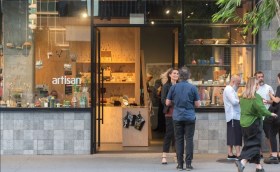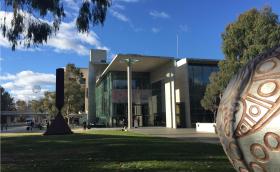Photojournalism is a long misunderstood medium. Treading between the lines of journalism and photography, it is often cast aside by art circles, who see it as little more than a practice of utilitarian documentation of the world rather than true artistic expression.
However, Barat Ali Batoor’s exhibition Searching for Sanctuary at State Library Victoria shows that photojournalism can have a place in the arts as its own form of expression alongside informative journalism. In Searching for Sanctuary, Batoor presents his year-long journey from Afghanistan to Australia as an asylum seeker through a multimedia display in such an awe-inspiring and emotional way that it raises the bar for future photojournalists and photographers alike.
Almost immediately when walking into the Keith Murdoch Gallery, viewers are confronted with an unsettling sense of grief. Inside a dark room riddled with intense contrasted lighting is a central screen playing film footage together with recorded spoken word pieces by Batoor.
Illuminated across the exhibition walls is a photographic timeline of his journey. Photographs from each location and date/timespan are grouped together as a series. Alongside the photos are captions from the subjects of the photos, or commentary from Batoor himself, which grounds the exhibition in the photojournalistic tradition and informs viewers of their context.
We learn of the countless perils that asylum seekers face, of the persecution of Hazaras, how the human smugglers of South-East Asia function. Searching for Sanctuary informs viewers not only of Batoor’s journey, but of the journey that many Afghan refugees face when arriving in Australia via boat. It’s portrayed in a deeply personal manner that would not be possible in a traditional news article or mere statistics.
Batoor’s timeline starts with photos from his Dancing Boys series, where he presented the plight of young Afghan boys forced into sexual slavery. It was these photos, which Batoor published in The Washington Post, that forced him into exile.
The timeline follows his border crossing into Pakistan, taking a flight to South-East Asia and then travelling to Australia by boat. The journey finishes with a photo of Batoor outside the Sydney Opera House after his asylum request was approved.
The photographs are unified in their haunting portrayal of danger across the different locations. Viewers are confronted by the faces of sexual abuse victims in Afghanistan, who were forced to dance and put on make-up, through the Hazara cemeteries in Quetta of the victims of the Taliban-led genocide, and onto the rusty boats full of desperate asylum seekers braving the Indian Ocean’s storms. Perhaps the most unsettling photo series of all is the one where there is only absence, as Batoor’s camera stopped working due to water damage after a storm on the Indian Ocean.
Although Searching for Sanctuary is primarily a photographic exhibition, the multimedia elements propel the exhibition to another level. Halfway across the “journey” one encounters a scrapbook containing a variety of illustrations, doodles, written pieces and language study material from previous asylum seekers that Batoor obtained from authorities in Kuala Lumpur. One can digitally flip through a scanned copy of this notebook via an iPad, allowing viewers to witness the fears, goals and struggles of learning English that many asylum seekers face.
What binds the whole exhibition together is a series of film footage and Batoor’s spoken word. In these, Batoor narrates the reasons why he had to leave Afghanistan. As he drove out of his home, Batoor recited poetry in Farsi/Dari that spoke to his feelings of exile. These words can be heard from across the room, so no matter where you are on the photographic timeline, viewers are reminded of the reasons why Batoor, and many others like him, had to go through such hardships.
Read: Exhibition review: Pharaoh, NGV International
It is a miracle that this exhibition could ever take place, not just given the perilous obstacles Batoor faced on his journey, but the fact that he managed to take such high quality photos documenting it.
Searching for Sanctuary is a reminder why such art is so important, and underscores the potential art has to inform us about the plights and hardships that some people have to face.
Searching for Sanctuary is showing at State Library Victoria until 6 October 2024; free entry.






